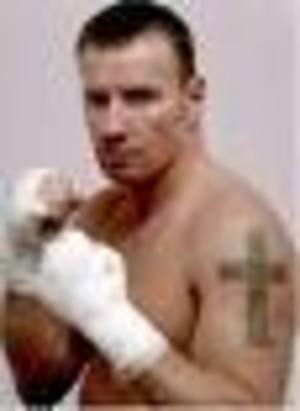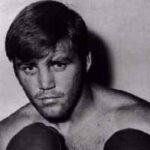In the sport of boxing, prizefighters are typically labeled as either a boxer or a brawler. The boxer is someone like Muhammad Ali, fast on his feet, quick with his hands, the type who will gradually wear down his opponent slick combination punching and sharp jabs. The brawler on the other hand is a very different fighter. He is slower on his feet, takes more punishment than the boxer, uses a technique that is not the prettiest or most refined, and has a tendency to get himself into trouble by not protecting himself. Despite his shortcomings however, the brawler is often tougher than your average boxer, a man with an iron jaw and fist who gives as good as he takes. The brawler is the kind of fighter who delivers the celebrated one-punch knockout. The brawler is always ready to slug it out until the bell rings for the final time. Win or lose the brawler excites and inspires other fighters with his tenacity and grit.
Micky Ward was such a fighter.
Born in Lowell, Massachusetts on October 4, 1965, Micky ward grew up in a large working-class Irish-Catholic family. One of nine children, money was always tight in the Ward home. As a young boy Ward became interested in boxing through his half-brother and promising fighter Dicky Eklund who once endured a 1978 bout with the great Sugar Ray Leonard. Ward’s amateur career in boxing began while he was in high school. A tough kid with able to deliver devastating body punches, Ward went on to win the New England Golden Gloves championship three times before deciding to turn professional in 1985. When not fighting Ward supported himself through construction work handling mostly road crew jobs. Ward eventually married his long-time girlfriend and they had a daughter before the marriage ended in a bitter divorce in which his wife was awarded primary custody of their daughter.
As a professional fighter, Ward’s career got off to a very promising start. He managed to win his first fourteen fights, most of them by knockout. However, his career soon took a different turn when he lost four consecutive fights. Discouraged, Ward took a break from boxing and considered giving it up altogether. By 1990, the twenty-five year-old Ward was back to working construction full-time. During his time away from boxing Ward had surgery on his right hand which had given him several problems while fighting and may have directly contributed to his slump. Ward’s return to the ring was brought about by his half-brother Dicky Eklund after the latter had been released from prison numerous drug offenses. Eklund, who would be featured in an HBO documentary chronicling drug addiction, had fallen from grace years ago and saw the potential in his brother. Able to convince Ward to take up boxing once again, Eklund, after finally kicking his crack-cocaine addiction, went on to act as Ward’s trainer.
Micky Ward’s return to the ring saw him win his first nine fights. In 1997, Ward lost a bid for the IBF Light Welterweight (or Junior Welterweight) title against the current champion Vince Phillips. The fight was stopped in the third round when it was determined that Ward had sustained too many cuts to his face. Phillips was awarded a TKO (technical knockout). Three years later Ward took on the WBU Light Welterweight champion Shea Neary in London, England. After losing most of the early rounds, Ward came back to earn a TKO in the eighth round. Finally the champion, Ward would keep the title for roughly a year but did not defend it instead deciding to split his next four fights.
Although his reign as champion had been short and uneventful, Micky Ward’s legacy would be forever sealed in boxing lore with his three bouts against the legendary (and late) brawler Arturo Gatti. The first of their three fights took place on May 18, 2002. Heavy exchanges occurred throughout the match and for awhile it seemed that either fighter could take the bout. However, in the ninth round Ward knocked Gatti down which turned the tide of the fight. In the end, Ward walked away with a majority decision and the win. Ring Magazine, arguably boxing’s most respected publication, named the fight 2002’s Fight of the Year. The second of their trilogy took place in November of the same year. Even though it was another brutal showdown, Gatti won the decision. He’d knocked Ward down in the third round and from then on had managed to control most of the fight. With the score even the pair decided to duke it out one more time. On June 7, 2003, Ward and Gatti traded punches one last time in another exciting and violent brawl that ended in Gatti taking the unanimous decision despite being knocked to the canvas in the sixth round. Ring Magazine named the fight the Fight of the Year. Later on in the same year, Micky Ward retired from professional prizefighting with a record of 38 wins with 27 coming by way of knockout, 13 losses, and no draws.
Since leaving the sport of boxing, Micky Ward has settled into a quiet, ordinary life. He is remarried and sees more of his daughter than before. He owns and operates a boxing gym where Dicky Eklund trains up-and-coming young fighters. In 2010, the story of the two brothers was notably chronicled in the film “The Fighter” starring Mark Wahlberg as Micky Ward and Christian Bale as Dicky Eklund. Ward’s likeness has also been featured in several boxing video games. He was not the best fighter. He wasn’t even a great fighter. What Micky Ward was, a tough, ferocious hitter that more often than not found a way to make his performances exciting and inspiring, will live on as an example of the competetive human spirit. Micky Ward was and forever will be an American brawler.




